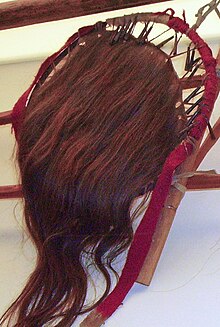Rind
As a scalp (including scalp ) refers to the functional unit of skin , subcutaneous tissue and tendons hood ( galea aponeurotica ) to the cranial vault ( Calvaria ). The loose subaponeurotic connective tissue connects the tendon hood with the periosteum , which enables the scalp to move freely ( subgaleotic or subgaleal shifting layer ). The scalp is typically 5 mm thick in an adult . The arteries of the scalp run in connective tissue canals in which they are hardly anchored. They also supply the periosteum of the skull, the outer lamina (lamina axterna) of the underlying skull bones and also anastomose with the middle meningeal artery . Specifically, these are the supratrochlear arteries and the supraorbital arteries in the forehead region and the superficial temporal artery in the area of the temple . The veins of the scalp are firmly anchored in the subcutaneous layer and are connected to the cerebral blood conductors via venae emissariae . The nerves are supplied via branches of the trigeminal nerve and via dorsal and ventral branches of the first cervical nerves.
The firm connection between the skin and the tendon hood is responsible for ensuring that wounds do not gape as long as the latter is not severed. In addition, bleeding can hardly spread under the skin, so that bumps develop. Since the scalp is very well supplied with blood and the veins are firmly embedded in the subcutaneous layer, the vascular wall cannot contract if injured, so that even small scalp wounds usually look more threatening than they actually are. However, a laceration should always be checked by a doctor and a traumatic brain injury or cerebral haemorrhage should be excluded.
Scalp
When scalping, the scalp is pulled from the skull , whereby the periosteum can be detached from the bone relatively easily . When opening a corpse , this fact is used to remove the brain for examination, but without neglecting the cosmetic aspect, which is important, for example, when laying out the corpse . To do this, the skin on the back of the head is separated and pushed forward to the forehead , which creates enough space to saw open the top of the skull. Later the scalp is turned back and the skin incision is sutured.
Even injuries are possible in this way: If hair is pulled into rotating machinery, the entire scalp is torn off. This is why health and safety regulations stipulate that if you have long hair you must wear a hat before you approach a running machine with dangerous moving parts (e.g. conveyor belts, chains, gear wheels, etc.). While an adequate blood supply to the detached part of the scalp can still be guaranteed in the case of a pedicled scalping injury, a total tear almost always requires a skin transplant . For this purpose, after the hair has been shaved and cleaned, the scalp is first used as a biological bandage until a suitable transplant bed of granulation tissue is formed.
In the literature, the ritual of scalping is mentioned as a victory trophy for North and South American Indians. With a few exceptions, apparently only opponents killed in combat were deprived of their scalps. Whether the ritual of scalping was originally Indian or was introduced by the Europeans is partly controversial. The removal of the scalp is already documented in the Old Testament and was also described by the Scythians .
Web links
Individual evidence
- ^ A b c Karl Zilles, Bernhard Tillmann: Anatomie . Springer, Berlin 2011, ISBN 978-3-540-69483-0 , pp. 784-785 .
- ^ Helmut Keudel: teething troubles . Gräfe und Unzer, 2009, ISBN 978-3-8338-1456-3 , p. 234 .
- ↑ Bernhardt Fischer, E. Goldschmidt, Benno Elkan: The section course, short instructions for the pathological-anatomical examination of human corpses . Springer, 2013, ISBN 978-3-642-91076-0 , pp. 26-28 .
- ↑ Volker Schumpelick, Niels Bleese, Ulrich Mommsen: Short textbook surgery . 8th edition. Georg Thieme, Stuttgart 2010, ISBN 978-3-13-152508-6 , p. 31 .
- ↑ Thomas Jeier: The first Americans: A history of the Indians . DVA, 2011, ISBN 978-3-641-06592-8 .
